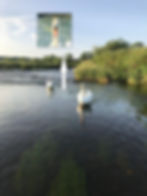Swan River Not Lake!
- John
- Dec 6, 2020
- 3 min read
The previous Discovery blog looked at manmade flying machines. This blog looks at one of nature’s flying marvels the Swan. The scientific name Cygnus derives from Greek or Latin words for swan. The males are called cobs because of the knob shaped beak from the old German word ‘Knopf’. Females are called pens from an old English word Penne because of the way they hold their wings back in a penned manner. Young swans are known as swanlings or cygnets from a variant of their Greek name. They start life brown and grey in colour until white as adults. Described in the story The Ugly Duckling by Hans Christian Andersen.
We are fortunate enough to have these majestic birds here in the village. Majestic, is a good description as the Queen ‘technically’ has the right to claim ownership of any mute swan which is unmarked and swimming in open water. In fact it took until 1998 for the law to change so it was no longer treasonous to eat a swan in the U.K. But as a native species, mute swans are now protected as wild birds under the 1981 Wildlife and Countryside Act and under this law it is still illegal to keep or kill them.
There are 4 non-native species of Swan, Black, Trumpeter, Tundra and Black-Necked. And there are 3 types of swan that can be potentially seen locally.
The most common is the Mute Swan (Cygnus Olor) which is a permanent resident as it does not migrate. It’s most distinctive feature is its orange and black beak. They have a huge wingspan of up to 2.4 metres (almost 8 feet) and males weigh between 11-12kg (1.9 stone). With an approximate 12 year lifespan. It's name was given as it is less vocal than other swan species. There are around 32,000 in the UK which equates to 1/7th of the world’s population.
The below photo was taken near Canny Island. I have zoomed in the image so the orange and black beak can clearly be seen. They are potentially an aggressive bird especially if they have young and could harm humans and will kill other waterfowl for feeding or nesting grounds. Basically like any wildlife enjoy their presence from a distance and do not disturb them. Also without stating the obvious, there has been recent reports of Avian Influenza at the Lindisfarne Nature reserve so do not approach or touch any ill or dead birds. See below link for more information.


The second swan to be seen locally is the migratory Whooper Swan (Cygnus Cygnus) which is slightly smaller than the Mute variety. They migrate to the UK each winter from Iceland.
The main distinctive difference from the Mute Swan is that Whoopers have a yellow and black beak. I took these photos near Blount Island.


A group of swans in flight is called either a ‘bevy’ or ‘wedge’. I think they are equally impressive in flight as the Hercules aircraft especially on take-off and landing in the river. Small birds take off almost instantly whereas swans require at least 30 yards (28 metres) from land to become airborne.
The sound of their wings flapping and calls are also a joy to hear.

This ‘wedge’ of Whoppers was flying low towards Pedwell.
The third and rarer variety is the Bewick Swan (Cygnus Bewickii) which sounds similar to Berwick and it was actually named after a Northumbrian engraver Thomas Bewick in 1830 who illustrated birds and animals. Our resident wildlife photographer Ronnie Hek has seen a few of them here in the past but they are becoming increasingly rare due to habitat loss and the perilous journey of thousands of miles as they migrate from the Artic tundra. They also have a yellow and black beak and they are slightly less in size than the Whopper Swan and are less vocal.
One of nature’s quirks is a ‘Swoose’ which is the result of a male swan breeding with a female goose and they are few documented records of these hybrids.
Geese and Swans can often be ‘honking’ on Blount Island at night. The different calls are believed to be alarm calls and for a temporarily lost goose to be able to re-join its family members.
Swans diet consists of aquatic vegetation which their long necks enable them to take from the river bed. They will also eat small fish, frogs and worms. They will also eat short-cropped grass in fields.
Large numbers can also be seen at the Tweed estuary and they can also been seen on the sea.
Swans mate for life unlike most other bird species. Hence the rarity of any Swoose!
Further online resources are shown below.
http://www.swan-trust.org/ (Local Charity at Berwick)
----------------------------------------------
Many thanks Ronnie Hek for your input on this blog.
